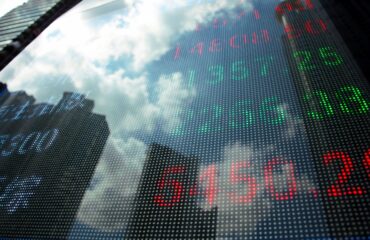Welcome, dear reader, to an interesting tapestry of global finance, where hope and apprehension play a delicate dance, mirroring the dance of politicians, central bankers, and of course, the high lords of technology.
The curtain rises on the Asian equity markets, projected to encounter a minor dip after an ambiguous performance by their American counterparts. Indeed, futures across Japan, Australia, and Hong Kong do not predict a pleasant start to Wednesday. All eyes remain keenly trained on China’s Purchasing Manager Index data. The Middle Kingdom’s economy, in its shaky revival, sends ripples through its equity and currency markets.
Moving westward across the Pacific, the S&P 500 played an uninspiring symphony, finishing Tuesday virtually unchanged while managing to hang just above the 4,200 mark. Yet, the energy sector served as a drag, reminding us of the risks of over-reliance on a resource as fickle as oil. An incongruous picture emerged in the tech sector; The Nasdaq 100 exhibited a 0.4% gain, a moderate sequel to its robust 31% year-to-date run, partly propelled by Nvidia Corp’s ambitious AI announcements nudging it tantalizingly close to a trillion-dollar valuation.
The Congress and the debt accord played the lead roles in the American theatre, evoking a sense of a classic tragedy where the lead characters fail to see the impending catastrophe. Yet, as the Congress inches closer to the accord, the debt ceiling emerges like a menacing ogre, threatening to engulf the US in a catastrophic default. Its silhouette is enough to tug Treasury yields from their highest levels since March.
Speaking of yields, there’s a strange dichotomy at play. While Treasury yields on 3-to 10-year maturities are leading the retreat, the two-year yield seems to be an anomaly. Hovering around 4.45%, it’s more sensitive to the Federal Reserve’s pulse than its longer-duration peers. The question remains – is it predicting a premature tightening, or merely reflecting short-term uncertainties?
Now, the bond market has always been a studious elder sibling to the boisterous equity market. As of late, though, they seem to be singing from different hymnals. Billionaire Cliff Asness has aptly expressed his concern over the diverging signals these markets are emitting on the matter of inflation. Stocks seem to be taking a laissez-faire attitude, expecting inflation to cool off on its own. Bonds, on the other hand, are bracing for a series of aggressive interest rate cuts by the Fed. The question is, who will end up playing the prophet, and who the fool?
The Federal Reserve, for its part, appears to be as perplexed as the rest of us. Richmond Fed President Thomas Barkin candidly admitted that he’s seeking evidence of cooling demand before declaring inflation a tamed beast.
Meanwhile, US consumer confidence has staggered to a six-month low, presumably echoing concerns around labor market conditions and business outlook. The specter of the debt ceiling debate looms large over these sentiments.
Looking at the events ahead, data-rich days lie in front of us. China’s manufacturing PMI, the Federal Reserve’s Beige Book, initial jobless claims in the US, ECB President Christine Lagarde’s speech, and the US unemployment and nonfarm payrolls, are some of the notable events that can set the tempo for the markets.
To wrap up the proceedings, the global financial markets, much like a Dickensian novel, are embodying the best and worst of times. On one hand, there are hopeful signs of progress – burgeoning tech valuations and hopeful congressional moves. On the other, the specter of defaults, an unsettling drop in consumer confidence, and confusion over inflation loom ominously.
Let’s strap in and observe the dance of the markets – a ballet, a waltz, or a mosh pit, only time will tell. Stay tuned, for the curtains have only just risen.
A string of manufacturing indices from China and the Eurozone, coupled with employment data from the US, stand as the lodestar for global market participants this week. Chinese manufacturing and non-manufacturing PMIs are due to be released, a key indicator of China’s economic health and often a precursor to future policy actions. Any oscillation could potentially disturb the delicate balance of the Asian markets, particularly given China’s pivotal role in the region. The Caixin manufacturing PMI, another Chinese bellwether, would also be under the investors’ microscope.
The Eurozone also steps into the limelight with the release of the HCOB Eurozone Manufacturing PMI, CPI, and unemployment data. As inflation concerns loom over the markets, any fluctuation in these indicators could have a ripple effect on global markets, given the interconnected nature of our economies.
Meanwhile, the United States sees a busy week with the Federal Reserve’s Beige Book and statements from Fed officials Patrick Harker, Susan Collins, and Michelle Bowman, which might offer some clues to the Fed’s mindset amidst the bond-market equity-market divergence. Initial jobless claims, construction spending, and ISM Manufacturing data will further provide insights into the US economy. The crescendo builds up to Friday’s unemployment and nonfarm payrolls data, which might set the tone for the markets going into the next week.
ECB President Christine Lagarde’s conference speech will also be closely followed by investors for any hints of Europe’s stance on the inflation question.
On the home front, stocks continue to tread water with S&P 500 futures little changed from Tuesday. The Nasdaq 100, bolstered by Nvidia’s performance, rose 0.4%, demonstrating the resilience of the technology sector in the face of broader market uncertainty. In contrast, futures in Asian markets, such as Japan’s Nikkei 225 and Australia’s S&P/ASX 200, forecast declines, indicating a somewhat tentative stance in the region.
On the currency front, major currencies remained relatively stable in early Asian trading, with a mild downturn in the dollar coinciding with a dip in Treasury yields. The yen held strong against the dollar as Japanese officials signaled potential intervention to support the currency.
In the commodities market, West Texas Intermediate crude oil made a modest gain to $69.55 a barrel, despite dragging on the S&P 500 earlier. Gold, often seen as a barometer of market sentiment, remained steady, reflecting a sense of cautious calm among investors.
Cryptocurrencies, the new kids on the block, saw minor declines, with Bitcoin and Ether dropping 0.2%. Although often volatile, the minor movements suggest a relatively stable outlook for these digital assets.
On the bond market, the yield on 10-year Treasuries saw an 11 basis point drop to 3.69% on Tuesday, while Australia’s 10-year yield mirrored this decline, dropping five basis points to 3.63%. The interesting tug-of-war between bond yields and equities raises the question of whether this is a sign of a correction or merely market noise.
As we head deeper into the week, the tapestry of global finance will continue to unravel, offering a spectacle of data, policy, and market reactions that would keep every observant investor on their toes. Let’s stay tuned and see how the markets dance to the tunes of the unfolding global economic symphony.



